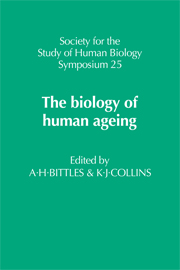Book contents
- Frontmatter
- Contents
- Preface
- Ageing as a consequence of natural selection
- Genetic information in ageing cells
- Insects as models for testing theories of ageing
- Human cell culture systems in the study of ageing
- Estimation of biological maturity in the older child
- Biological age assessment in adulthood
- Skeletal age and palaeodemography
- Cell death and the loss of structural units of organs
- The prospects for mortality decline and consequent changes in age structure of the population
- Where do old people come from? An evaluation of American population projections
- Age structure of Soviet population in the Caucasus: facts and myths
- The health of an ageing population
- Can we tell our age from our biochemistry?
- Dietary manipulation of ageing: an animal model
- Customary physical activity in the elderly
- Effects of ageing on human homeostasis
- Index
Ageing as a consequence of natural selection
Published online by Cambridge University Press: 06 August 2010
- Frontmatter
- Contents
- Preface
- Ageing as a consequence of natural selection
- Genetic information in ageing cells
- Insects as models for testing theories of ageing
- Human cell culture systems in the study of ageing
- Estimation of biological maturity in the older child
- Biological age assessment in adulthood
- Skeletal age and palaeodemography
- Cell death and the loss of structural units of organs
- The prospects for mortality decline and consequent changes in age structure of the population
- Where do old people come from? An evaluation of American population projections
- Age structure of Soviet population in the Caucasus: facts and myths
- The health of an ageing population
- Can we tell our age from our biochemistry?
- Dietary manipulation of ageing: an animal model
- Customary physical activity in the elderly
- Effects of ageing on human homeostasis
- Index
Summary
INTRODUCTION
The process of ageing is familiar in all human societies. From early in childhood we learn to recognise the signs of senescence, and quickly we become adept at combining a variety of visual and behavioural clues to derive a reasonably accurate impression of a person's age. This awareness of intrinsic mortality extends also to domestic and captive animals, and it leads almost naturally to the view that ageing is a form of inescapable deterioration which afflicts complex organisms in much the same way that mechanical breakdown occurs in machines. In consequence, we may be all too ready to take ageing for granted and to overlook the important question of why ageing should occur at all.
There are two reasons, at least, why we should be cautious about accepting the mechanistic view that ageing is inevitable. Firstly, ageing is not intrinsic to all living organisms. Bacteria and many eukaryotic microorganisms can divide indefinitely, many plants are capable of unlimited vegetative propagation, and some simple animals, such as coelenterates, have regenerative powers which apparently allow them to escape senescent changes (Comfort, 1979). Secondly, as Williams (1957) observed, the remarkable thing about ageing is that after its tremendous feat of morphogenesis a complex organism should be incapable of the seemingly much simpler task of merely maintaining what is already formed. Damage arises continually in organisms and their cells and powerful mechanisms exist to correct or repair these defects.
- Type
- Chapter
- Information
- The Biology of Human Ageing , pp. 1 - 16Publisher: Cambridge University PressPrint publication year: 1986
- 23
- Cited by



